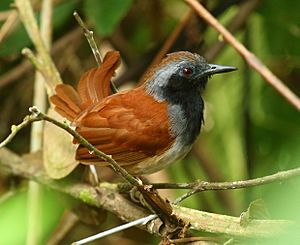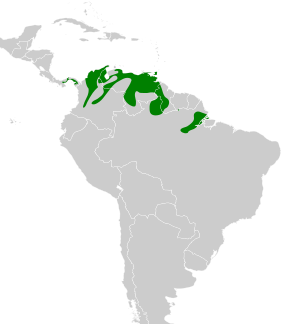White-bellied antbird facts for kids
Quick facts for kids White-bellied antbird |
|
|---|---|
 |
|
| Male near Morne La Croix, Trinidad | |
 |
|
| Female | |
| Conservation status | |
| Scientific classification | |
| Genus: |
Myrmeciza
|
| Species: |
longipes
|
 |
|
The white-bellied antbird (Myrmeciza longipes) is a small passerine bird that lives in warm, tropical areas. You can find it from Panama all the way to northern Brazil, and also on the island of Trinidad. Sometimes, especially in older books, it's called Swainson's antcatcher. This name comes from William Swainson, the scientist who first described this bird. It's special because it's the only bird left in its group, called Myrmeciza.
Contents
About Its Name and Family
Every living thing has a scientific name, and the white-bellied antbird's is Myrmeciza longipes. An English scientist named William Swainson first described this bird in 1825. Later, in 1841, another English zoologist, George Robert Gray, created the group Myrmeciza for this bird.
For a long time, this group had more than 20 different bird species. But in 2013, scientists studied the birds' DNA. They found that the Myrmeciza group, as it was, wasn't quite right. So, they reorganized the birds into 12 new groups. This left the white-bellied antbird as the only member of the Myrmeciza group.
Different Types of White-bellied Antbirds
There are four slightly different types, or subspecies, of the white-bellied antbird:
- M. l. panamensis: Found in eastern Panama and northern Colombia.
- M. l. longipes: Lives in northeastern Colombia, northern Venezuela, and Trinidad.
- M. l. boucardi: Found in north-central Colombia.
- M. l. griseipectus: Lives in southeastern Colombia, southern Venezuela, the Guianas, and northeastern Brazil.
What the White-bellied Antbird Looks Like
This antbird is about 15 centimeters (6 inches) long and weighs around 26 grams (less than an ounce). It has a reddish-brown back and whitish feathers on its belly. Its sides and lower belly are a cinnamon-buff color. You might notice a long grey stripe above its eye, which is called a supercilium. Its pink legs are long and strong, which helps it move around on the ground.
Male vs. Female Antbirds
Male white-bellied antbirds have a black face, throat, and upper chest. Females look a bit different. Their head is darker, they have grey patches on their cheeks, and small dark spots on their wings. They don't have the black markings that the males do.
One type of white-bellied antbird, called griseopectus, is special because both the males and females have black spots on their wings and grey feathers on the middle of their undersides.
Where They Live and What They Eat
White-bellied antbirds prefer to live in forests, especially in the thick plants and bushes close to the ground. They like both dry and moist forests where trees lose their leaves.
These birds are insectivores, which means they eat insects. They mostly look for ants and other small creatures like spiders (called arthropods) on or near the ground. Sometimes, they even follow groups of army ants to catch the insects that the ants stir up.
Nesting and Sounds
White-bellied antbirds build their nests in trees. The female usually lays two or three eggs. Both the male and female birds take turns sitting on the eggs to keep them warm until they hatch.
You might hear a white-bellied antbird before you see it! They have a bright, descending song that sounds like jeer-jeer-jeer-jeer-jeer-jeer-jeer-jeer-jeer-jeer-jeer-jeer, which then ends with a few chew notes.
See also
 In Spanish: Hormiguero ventriblanco para niños
In Spanish: Hormiguero ventriblanco para niños


